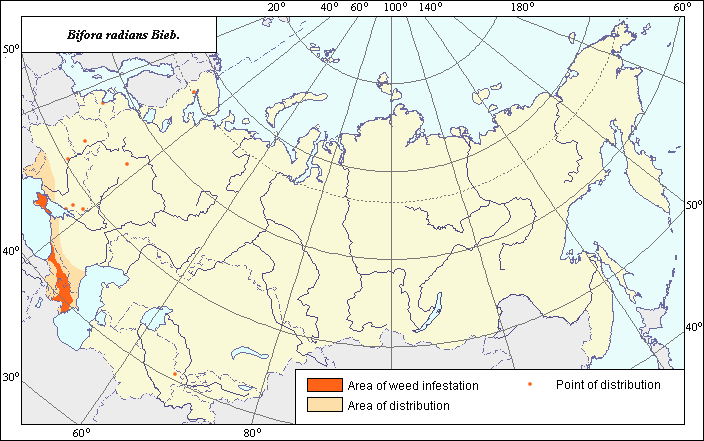Weeds
Area of distribution and weediness of Bifora radians Bieb.
 Object description Download GIS-layers
Object description Download GIS-layers
Authors:
Object specialist - S.Yu. Larina,GIS-specialist - I.A. Budrevskaya
Date of creation:
15.11.2004Scale:
1:20 000 000Accuracy of map:
Map was created based on materials of maps of natural scale 1:5 000 000 - 1:100 000 000.Projection:
"Alber's Equal Area Conic for the USSR", 9, 1001, 7, 100, 0, 44, 68, 0, 0Basic contents:
Vector map. Area of species distribution is shown by polygons, and sporadic distribution by points. Zones of weediness are shown by polygons.Accuracy of classifier:
The weed area is subdivided into two zones, one representing species distribution, and the second where weed is considered a serious pest. Points represent locations where sporadic occurrence has been reported. Within the weed area of Bifora radians the zones of its weediness were established according to criteria of occurrence (% of fields where this species is found) and abundance (expressed as projective cover of this species in the field (in % to the field area)), where the occurrence of this species exceeded 20% with its abundance (projective cover) more than 15% (Tanskii et al., 1998).Method of map production:
Published literature was reviewed, including Atlases, monographs and papers. The distribution of this species was determined according to the map of Volkov (1935). The areas of weediness were established according to Nikitin (1983) and coordinated with the limits of arable lands (Korlojeva et al, 2003). The sites of sporadic distribution of Bifora radians were depicted in the central and northern regions of the European part of the Former Soviet Union according to the following sources: Makarov & Ignatov (1983), Mosyakin (1991), Notov & Sokolov (1994), Tabaka et al. (1988), Tretyakov (1998); within the southern Ukraine they were established according to Tokhtar (1994). Sporadic distribution of this species in the Caucasus was determined according to Grossgheim (1967) and was included in the main area which agrees with the data of Volkov (1935). Data were compiled through scanning and geo-referencing to develop a composite vector map. The biologist, together with the GIS specialist, drew a composite weed distribution area based on compiled data.Reference citations:
Agaev M.G., ed. 1993. Useful weed plants in flora of the USSR. In: Catalogue of VIR world collection. N. 643. Leningrad: VIR. 160 p. (In Russian)Grossgeim, A.A. 1967. Flora of the Caucasus. V. 7. Leningrad: Nauka. 894 p. (In Russian)
Keller B.A., ed. 1934. Weed plants of the USSR. V. 3. Leningrad: AN SSSR. 448 p. (In Russian)
Koroljeva IE, Vilchevskaya EV, Ruhovich DI. 2003. Digital Arable Land Map. Laboratory of Soil Information of the Dokuchaev Soil Institute, Moscow, Russia [Based on: Yanvareva LF. (ed.), Martynjuk KN., Kisileva NM. 1989. Map of Land Use, Faculty of Geography, Moscow State University, Moscow, Russia.].
Lenkov P.V. 1932. Seeds of field weeds from European part of the USSR. Moscow-Leningrad: State Publishing House of Kolkhoz & Sovkhoz Literature. 320 p. (In Russian)
Makarov, V.V. & M.S. Ignatov. 1983. For adventive flora of Moscow. In: Lapin P.I., ed. Bulletin of the Main Botanical Garden of Ac. Sc. USSR. Issue 127. Moscow: Nauka. 38-42 p. (In Russian)
Mosyakin S.M. 1991. Additions and specifications to adventive flora of Kiev. Ukrainian Botanical Journal, 48(2): 54-7. (In Ukrainian)
Nikitin, V.V. 1983. Weed plants of the USSR flora. Leningrad: Nauka. 454 p. (In Russian)
Notov A.A., Sokolov D.D. 1994. New and rare species in flora of Murmansk region and Karelia. Botanicheskii zhurnal, 79(11): 92-5. (In Russian)
Shishkin, B.K., ed. 1950. Flora of the USSR. V. 16. Moscow-Leningrad: AN SSSR. 648 p. (In Russian)
Tabaka, L.V., Gavrilova, G.B. & I.Ya. Fatare. 1988. Flora of vascular plants of Latvian SSR. Riga: Zinatne. 196 p. (In Russian)
Tanskii V.I., Levitin M.M., Ishkova T.I., Kondratenko V.I. 1998. Phytosanitary diagnostics in integrated management of cereals. In: Novozhilov K.V., ed. Compendium of methodical recommendations in plant protection. Saint-Petersburg: VIZR. 5-55 p. (In Russian)
Tokhtar V.K. 1994. As to question about anthropochorous migration of plants along railroads. Ukrainian Botanical Journal, 51(6): 145-7. (In Ukrainian)
Tretyakov D.I. 1998. New adventive plant species for flora of Belorussia. Botanicheskii zhurnal, 83(9): 119-132.
Visyulina O.D., ed. 1970. Weeds of Ukraine (reference-identification guide). Kiev: Naukova Dumka. 508 p. (In Ukrainian)
Volkov A.N., ed. 1935. Areas of distribution of the major weed plants in the USSR. Moscow-Leningrad: Publishing House of Kolchoz & Sovchoz Literature. 153 p. (In Russian)
Wild bishop. 1999-2004. In: Weed database. Agricultural portal "Agro Mage". Ukraine, Poltava: http://agromage.com/weeds_id.php?basa=1&la=ru&let=1968&id=bifra . (In Russian)
Wild bishop. 2003. In: Information database. Chemical control. Agrarian sector of Ukraine: http://agroua.net/plant/chemicaldefence/weeds/t-1/st-1/bg-1/bc-2/w-113/ (In Ukrainian)
Right and copyright:
All rights reserved. Copyright 2004© S.Yu. Larina & I.A. Budrevskaya. The imageshttp://sophy.u-3mrs.fr/photohtm/SI98.HTM

